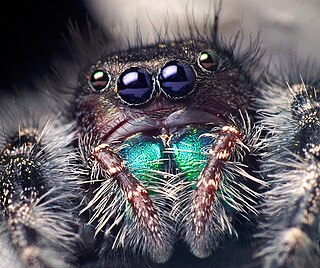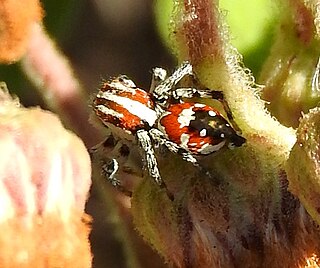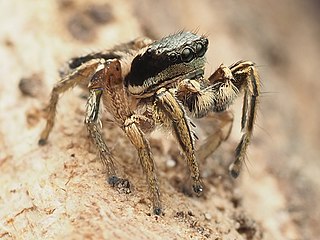
Myrmarachne is a genus of ant-mimicking jumping spiders that was first described by W. S. MacLeay in 1839. They are commonly called ant-mimicking spiders, but they are not the only spiders that have this attribute. The name is a combination of Ancient Greek μύρμηξ, meaning "ant", and ἀράχνη, meaning "spider".

Phidippus is a genus in the family Salticidae. Some of the largest jumping spiders inhabit this genus, and many species are characterized by their brilliant, iridescent green chelicerae. Phidippus is distributed almost exclusively in North America, with the exception of two exported species. As of January 2021, there were about 80 described species in the genus. Species previously described in Phidippus which are found in India and Bangladesh do not belong in this genus.

Habronattus is a genus in the family Salticidae. Most species are native to North America. They are commonly referred to as paradise spiders due to their colorful courtship ornaments and complex dances, similar to birds-of-paradise.

Beata is a genus of jumping spiders that was first described by George Peckham & Elizabeth Peckham in 1895.

Breda is a genus of jumping spiders that was first described by George Peckham & Elizabeth Peckham in 1894.

Euophrys is a genus of jumping spiders that was first described by Carl Ludwig Koch in 1834. The small black E. omnisuperstes lives on Mount Everest at elevations up to 6,700 meters, possibly making it the most elevated animal in the world.
Eustiromastix is a genus of jumping spiders that was first described by Eugène Louis Simon in 1902.
Hispo is a genus of the spider family Salticidae.
Kima is a genus of spiders in the family Salticidae.

Mendoza is a genus of jumping spiders that was first described by George and Elizabeth Peckham in 1894.

Naphrys is a genus of North American jumping spiders that was first described by Glavis Bernard Edwards in 2003. The name is a portmanteau of "North America" and "Euophrys".

Nycerella is a genus of spiders of the jumping spider family, Salticidae.

Zuniga is a genus of ant mimicking jumping spiders that was first described by George and Elizabeth Peckham in 1892. As of September 2019 it contains two species, found in South America, Costa Rica, and Mexico: Z. laeta and Z. magna. It is a senior synonym of Arindas and Simprulloides.

Zygoballus is a genus of jumping spiders found in North and South America.

George Williams Peckham and Elizabeth Maria Gifford Peckham were a married couple who were early American teachers, taxonomists, ethologists, arachnologists, and entomologists, specializing in animal behavior and in the study of jumping spiders and wasps.

Zygoballus sexpunctatus is a species of jumping spider which occurs in the southeastern United States where it can be found in a variety of grassy habitats. Adult spiders measure between 3 and 4.5 mm in length. The cephalothorax and abdomen are bronze to black in color, with reddish brown or yellowish legs. The male has distinctive enlarged chelicerae and front femora. Like many jumping spiders, Z. sexpunctatus males exhibit ritualized courtship and agonistic behavior.

Zygoballus rufipes, commonly called the hammerjawed jumper, is a species of jumping spider which occurs in the United States, Canada, and Central America. Adult females are 4.3 to 6 mm in body length, while males are 3 to 4 mm.

Zygoballus nervosus is a species of jumping spider which occurs in the eastern United States and Canada.

Habronattus mexicanus is a species of jumping spider in the genus Habronattus. The species was first identified in 1896 in Mexico, after which it is named, originally allocated to the genus Habrocestum. The species has subsequently been identified in locations in North and Central America, as well as islands in the Caribbean Sea. The spider is small, but displays one of the most complex sexual displays, including sophisticated vibatory song patterns.















